There’s twelve images here but this post is really about my experience using Canon’s “new” EF 100-400mm f/4.5-5.6L IS II USM lens in combination with a 1.4 extender (teleconverter).
My 500mm f/4 is in the shop for cleaning and possible repair so in the interim I’m using the 100-400 with attached tc on my Canon 7D Mark II for birds. In the past this lens (and its predecessor version one – the old “trombone” lens) wouldn’t autofocus on a cropped sensor camera but with the Mark II it will – but only to f/8. Anytime you use a teleconverter you lose at least some image quality – from a negligible amount with top of the line lenses like my 500 f/4 to significant amounts with lower quality glass.
I was curious to see how Canon’s relatively new 100-400 performed with the attached 1.4 tc on the Mark II and yesterday morning I had that opportunity with this cormorant. I’ve used that lens often on birds (and was happy with the results) but that was nearly always without the tc attached.
1/2000, f/8, ISO 800, Canon 7D Mark II, Canon EF 100-400mm f/4.5-5.6L IS II USM @ 400mm + EF 1.4 III Extender, not baited, set up or called in
I found the bird, a juvenile going into adult plumage, yesterday morning at Farmington Bay WMA. The wind was howling but the cormorant didn’t seem to mind it as it fished for its breakfast (I saw it swallow one fish in the few minutes I was there).
Right after emerging from a dive the cormorant unexpectedly executed an extended wing flap. I got 31 images of the performance and I’ve presented a dozen of them here, in the order they were taken. I’ll say nothing about the images individually and wait until the end of the post to provide my take on the performance of the lens + teleconverter.
1/1250, f/8, ISO 800, Canon 7D Mark II, Canon EF 100-400mm f/4.5-5.6L IS II USM @ 400mm + EF 1.4 III Extender, not baited, set up or called in
1/1250, f/8, ISO 800, Canon 7D Mark II, Canon EF 100-400mm f/4.5-5.6L IS II USM @ 400mm + EF 1.4 III Extender, not baited, set up or called in
1/1250, f/8, ISO 800, Canon 7D Mark II, Canon EF 100-400mm f/4.5-5.6L IS II USM @ 400mm + EF 1.4 III Extender, not baited, set up or called in
1/1250, f/8, ISO 800, Canon 7D Mark II, Canon EF 100-400mm f/4.5-5.6L IS II USM @ 400mm + EF 1.4 III Extender, not baited, set up or called in
1/1250, f/8, ISO 800, Canon 7D Mark II, Canon EF 100-400mm f/4.5-5.6L IS II USM @ 400mm + EF 1.4 III Extender, not baited, set up or called in
1/1250, f/8, ISO 800, Canon 7D Mark II, Canon EF 100-400mm f/4.5-5.6L IS II USM @ 400mm + EF 1.4 III Extender not baited, set up or called in
1/2000, f/8, ISO 800, Canon 7D Mark II, Canon EF 100-400mm f/4.5-5.6L IS II USM @ 400mm + EF 1.4 III Extender, not baited, set up or called in
1/1000, f/8, ISO 800, Canon 7D Mark II, Canon EF 100-400mm f/4.5-5.6L IS II USM @ 400mm + EF 1.4 III Extender, not baited, set up or called in
1/1250, f/8, ISO 800, Canon 7D Mark II, Canon EF 100-400mm f/4.5-5.6L IS II USM @ 400mm + EF 1.4 III Extender, not baited, set up or called in
1/2000, f/8, ISO 800, Canon 7D Mark II, Canon EF 100-400mm f/4.5-5.6L IS II USM @ 400mm + EF 1.4 III Extender, not baited, set up or called in
1/2000, f/8, ISO 800, Canon 7D Mark II, Canon EF 100-400mm f/4.5-5.6L IS II USM @ 400mm + EF 1.4 III Extender, not baited, set up or called in
Following are my unscientific observations about the quality of the results I got in this series as compared to what I think I would have achieved using my 500 f/4 with attached tc.
- Overall I think image quality (IQ), fine detail and apparent sharpness were all somewhat negatively affected by this combination. But that’s to be expected and I think these results are quite acceptable.
- Images taken with this lens have a different visual “feel” to them than those taken with my 500mm. It’s hard to put a finger on precisely what it is and I’m not saying it’s either bad or good, it’s just… different.
- Autofocus is noticeably slower using this combination and that will make it more difficult to photograph birds in flight.
- For me perhaps the most significant downside to this combo is the fact that I can only go to f/8 which reduces my available shutter speed. That effect can be seen in many of these cormorant shots (#3 and #4 for example) where 1/1250 sec just wasn’t fast enough to get the flapping wings sharp (at this aperture, focal length and shutter speed it was motion blur rather than a depth of field issue). I’d rather have been at f/6.3 which would have increased my shutter speed significantly. Next time I’ll probably increase my ISO to get more SS but that increases noise (I don’t like to go over ISO 800).
- On the plus side, what a dream the 100-400 is to hand hold over my monster 500mm!
But hey, we’re really comparing apples to oranges here and in some ways that isn’t fair. Look at the prices of these two lenses – at Amazon the 100-400 is $2049 while the 500 f/4 is a whopping $9000! In my experience we (usually) get what we pay for and in my opinion the new 100-400 is an excellent value and performs very well. And besides, when the 100-400 isn’t used with the teleconverter many of the issues I’ve listed are mitigated.
I’m very happy to have the Canon EF 100-400mm f/4.5-5.6L IS II USM in my arsenal!
Ron
Please note: This post isn’t meant to be a bona fide review of the lens – it’s only my anecdotal impressions of using it in combination with the 1.4 tc one time on one bird.
FYI – most of these images were cropped to 50-65% of the original image.
I realize that all this photo-geekiness will have limited appeal for some. Hopefully the images will help to make up for it.


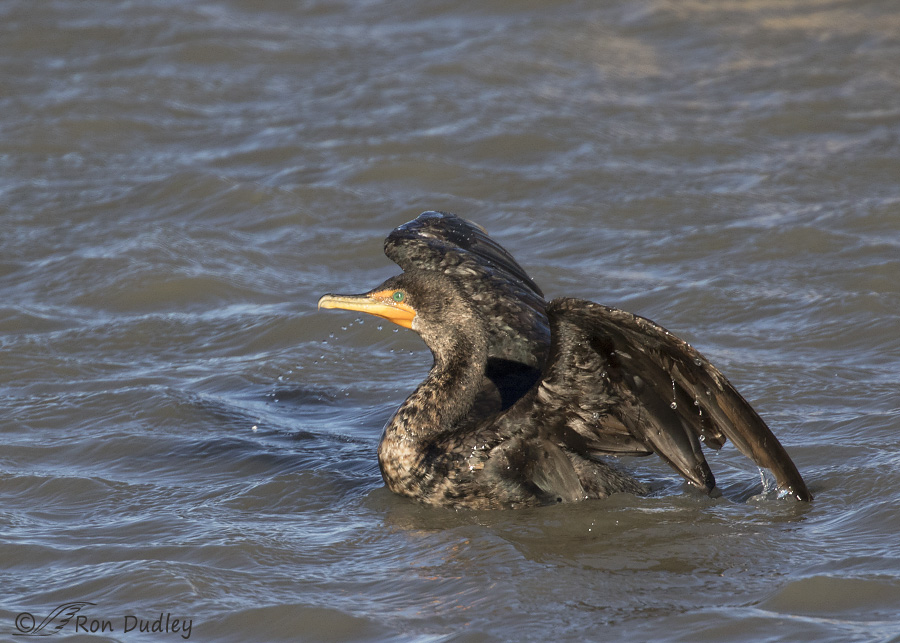
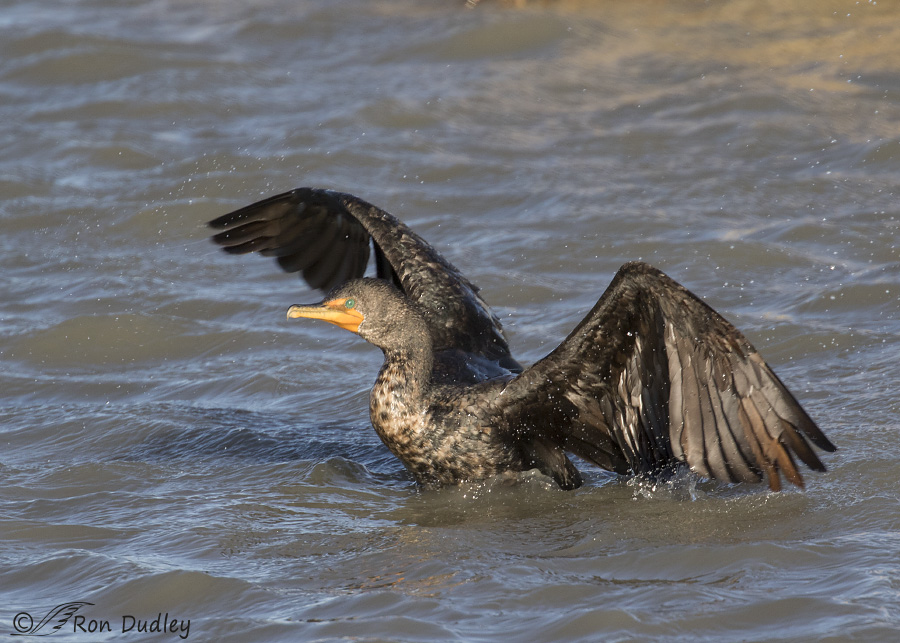
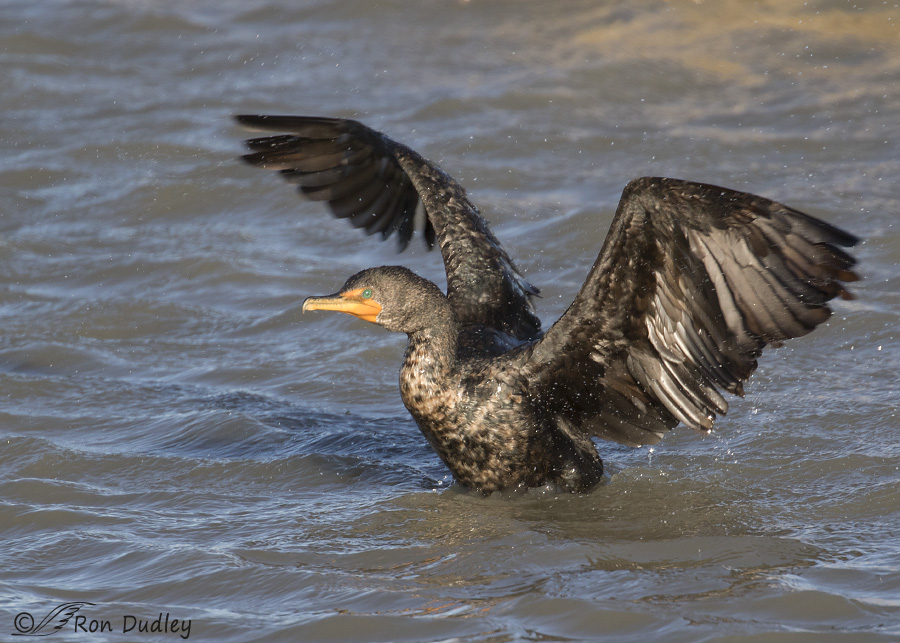
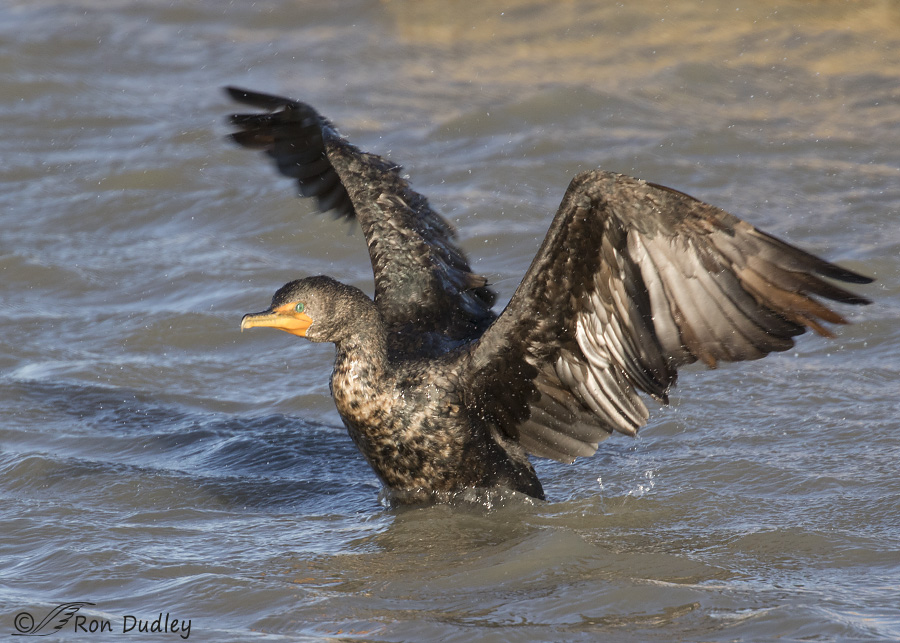
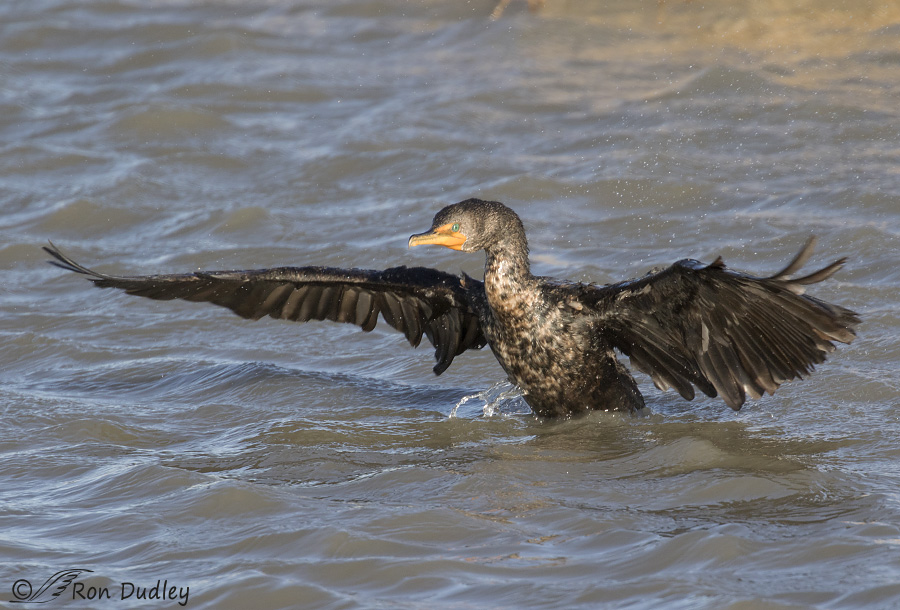
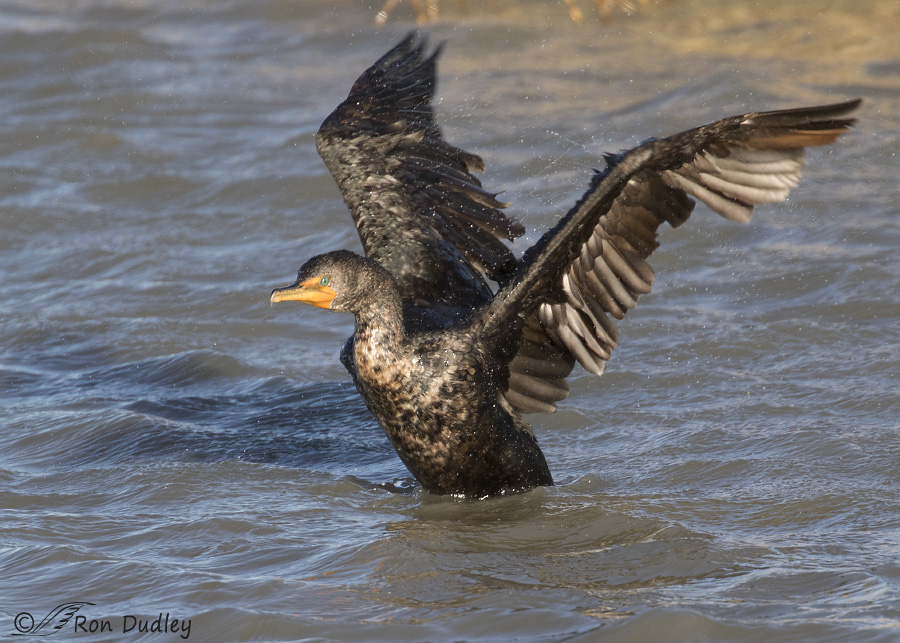
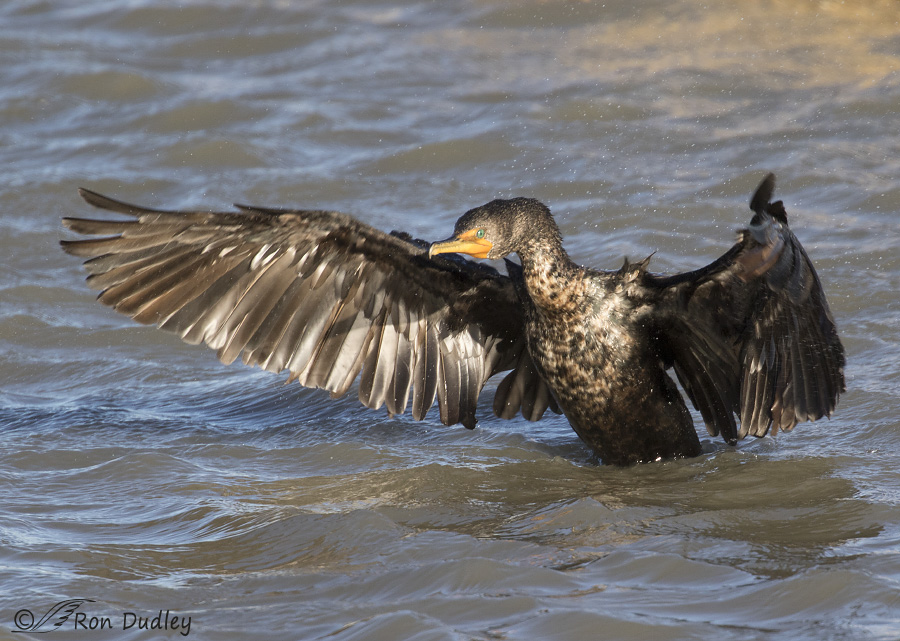
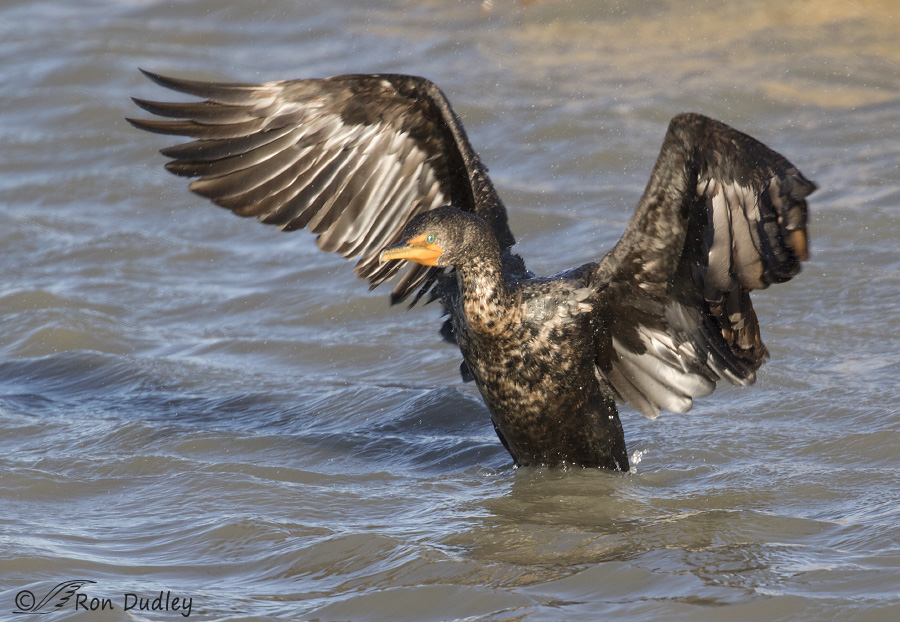
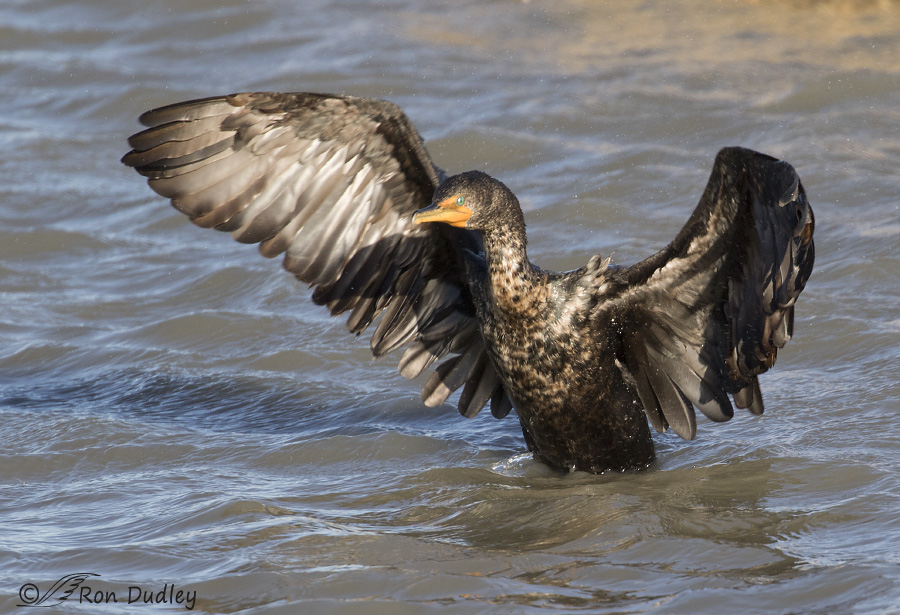
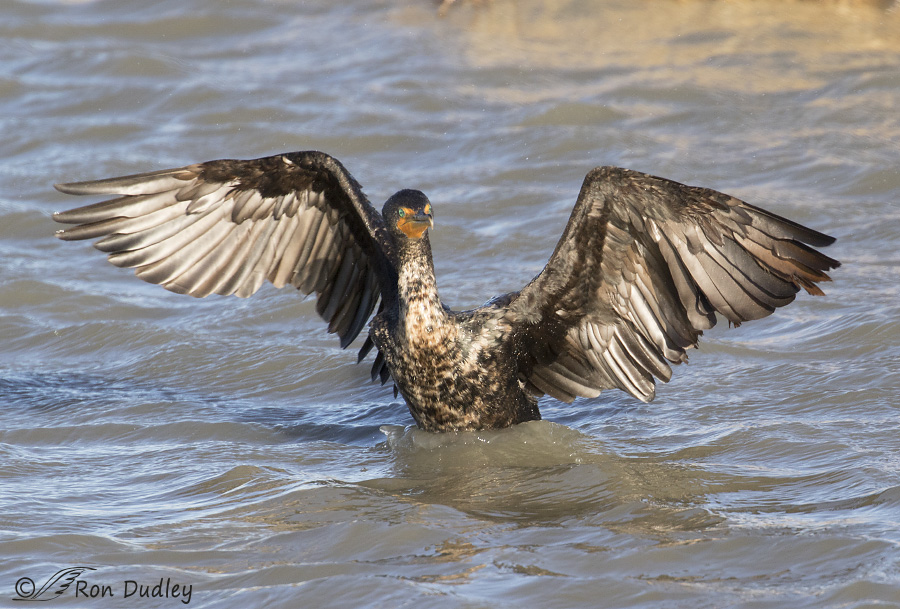
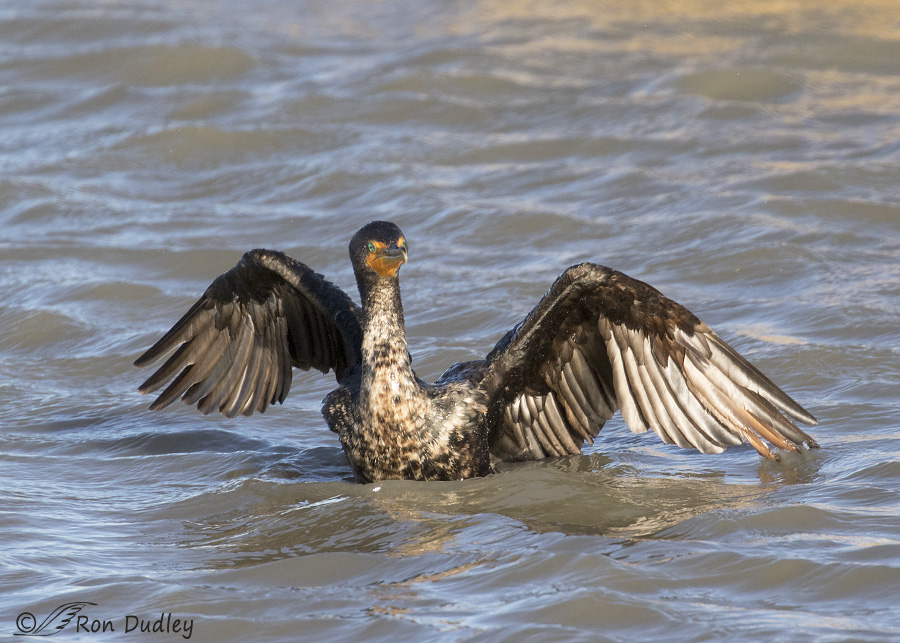
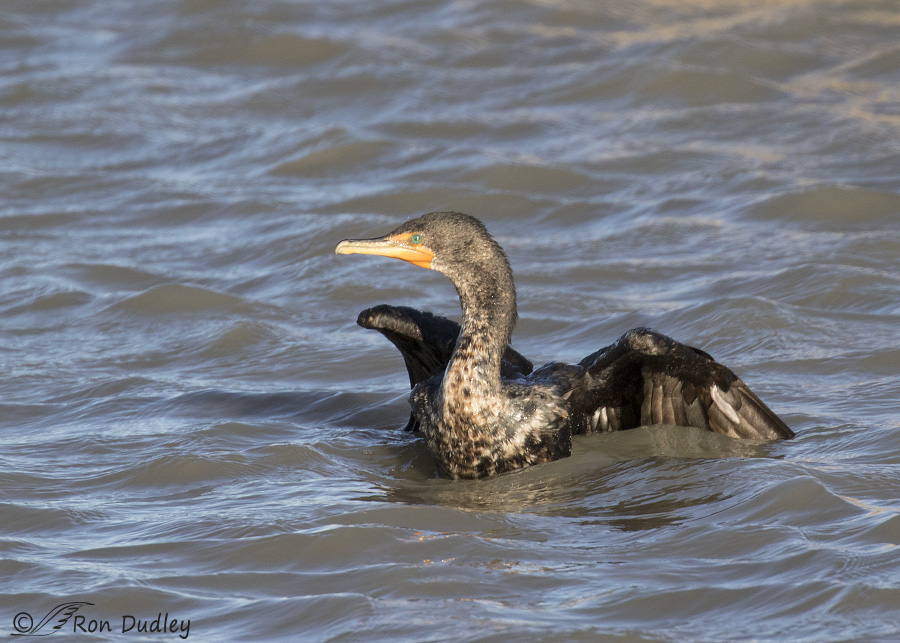
Interesting series…the water is especially so…the bird looks almost prehistoric…never noticed that before….
Patty – they’re often described as “prehistoric looking”. I’ve seen that point made often.
Thank you, this was wonderful. You have stated exactly all of my experiences with the same combination. I did not know if it was my newness to my gear or the limitations of the equipment. I have been using a ISO around 1000 to stop the wing blur but a few days when it was cloudy and I was trying to capture the fast moves of a Pied-billed Grebe I had the ISO cranked all the way up to 1600 to try to stop the wing blur. I managed to stop the flying water droplets but sill managed to get some wing blur. I have also noticed the AF is slower with the teleconverter on. I can’t always get a tack sharp image at the full extension of 560mm but between 300mm to 400mm I can get tack sharp images all the time.
April, Pied-billed Grebes are incredibly fast little birds and one of the most difficult species to photograph in action (running across the water, wing flaps etc). Bring on the clouds (and resulting low light) and the task becomes very, very difficult.
I forgot to mention I probably saw the same cormorant last Friday too. The first for the season for me. I also thought I saw a pelican with a tracking device and when I looked up pelicans with PeliTrack there is one in the area. Stupid little things like this give me goosebumps.
“Stupid little things like this give me goosebumps”
I’m still giggling over that one, April. We’re two peas in a pod!
There were 9 or 10 pelicans on the water west of the boat ramp at the “owl bridge” (there was also a single cormorant fishing cooperatively with them) but I didn’t see a tracking device.
This cormorant was at the 4-way pond.
Yep, same place and situation Friday.
I am not a camera geek, but it is interesting to see the difference in quality of the photos between your two lenses. I enjoyed the wing-flap series, but was actually able to see that most of the photos were softer than I usually see with your big lens. With regard to slowness with birds in flight, don’t you usually remove the teleconverter for take-offs or flight? Or at least try to do so if you have time? It seems to me to be a subject mentioned with some frequency in your posts.
“With regard to slowness with birds in flight, don’t you usually remove the teleconverter for take-offs or flight?”
I often do, Susan, but it depends on how close I am to the bird. And with the smaller zoom lens I usually wouldn’t be so close that I’d want to take the tc off.
Well, well, well, what a wonderful series and notes! You convinced me to dip into my reserves and buy the lens!! Hope they will give me something for my old 100-400. However I will probably put my 1.4 extender on the new lens and forget ever to take it off.
Many thanks for this post. I would probably up my ISO, not as concerned with what little noise I see, (probably my old eyes). LOL
You gotta do what you gotta do or afford what you can afford. Life is short, so go after it as best you can is my motto!
“You gotta do what you gotta do or afford what you can afford”
That’s exactly right, Dick!
I know you’ve been lusting after this lens for some time now so I hope you enjoy your new purchase as much as I think you will. There are MANY improvements over the old version (that you own and I used to own). I’ll mention just one – the more traditional zoom mechanism over the old push-pull “trombone” action. I much prefer the former!
These images are pretty nice Ron. Just to be sure, all the images in this post are with the 1.4x III extender? ( I did not see the extender listed in the image settings). Your post has boosted my confidence in this exact same setup { 7D2, 100-400 II, and the 1.4x) — I do notice a delay in autofocus acquisition that is noticeable. This concerns me for wildlife that is moving, however it may work out. Thanks for the interesting and useful post!
Sheesh, you’re right, ED. I forgot to include the extender in my image techs. I’ve now added it – a stupid mistake considering the subject of my post. Thanks very much for the heads up!
I find it takes me longer (and it’s more difficult) to acquire focus lock on a bird in flight with the extender attached. That will cause me to miss BIF shots that I have a better chance of getting with the 500mm.
Not quite as sharp, BUT! I think the f8 prevents the cormorant from standing out from the background as well. I’ll take them!
I think the f8 prevents the cormorant from standing out from the background as well. I’ll take them!  The weight of the lens and tc is certainly a break from the 500!
The weight of the lens and tc is certainly a break from the 500! 
“I think the f8 prevents the cormorant from standing out from the background as well”
You’re absolutely right about that, Judy – something I was going to mention and just forgot.
Thanks Ron, I appreciate the photography knowledge imparted. I am having fun learning my new 7D Mark II and my longest lens is an EF 70-200 F4L IS USM. I am having some learning curve issues however. I shoot in aperture priority which I believe you also use. I try and keep the shutter speed up to 1/2000 and as open an aperture as possible to maximize background blurring and try to use auto ISO but want also to keep it under ISO 800. Seems like I can’t routinely dial down the aperture and meet these other conflicting goals. Can I ask what your routine is when setting up a shot to maximize all three goals at the same time – Low ISO, Large aperture and ultrafast shutter speed? Thanks ahead of time….
Art, I never use auto ISO. I like to have control over it.
And when it comes to ISO, aperture and SS it all depends on the situation – perched bird versus flight or potential takeoff, lighting conditions, how close I am to the bird (for DOF considerations), the size of the bird (smaller birds move and beat their wings faster than larger birds) and a host of other factors.
Lots of things to think about and “learning curve issues” come with the territory. I’m STILL in a steep one after all these years!
Ron, do you have the 300mm f2.8? I find it’s an acceptable backup with a 2.0 teleconverter.
WC, No, I don’t – though I’ve heard it’s an excellent lens.
However, I REALLY appreciate the flexibility of the zoom and the new version of the 100-400 is a significant improvement over the old version.
The whole bird doesn’t seem quite as crisp as with the 500, but these are still some mighty spectacular shots! Those eyes are mesmerizing — I can honestly say I didn’t really look at anything else during my first perusal. I can see how the drop in shutter speed might affect shots of other species/actions, though.
If nothing else, you’re giving your hands, arms and shoulders a bit of a break. So, silver lining.
You’re right about the “crispness”, Marty – though it isn’t bad. More than the sharpness I noticed some loss in detail (though they’re obviously intertwined).